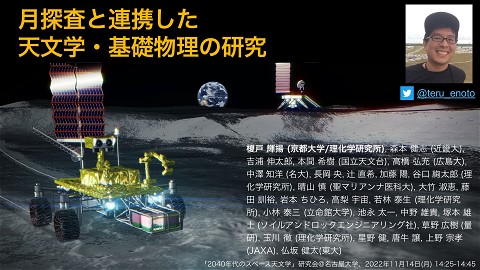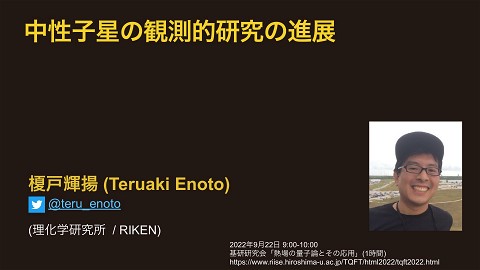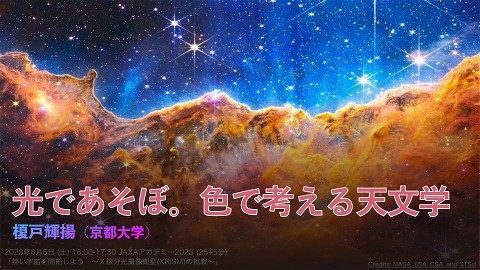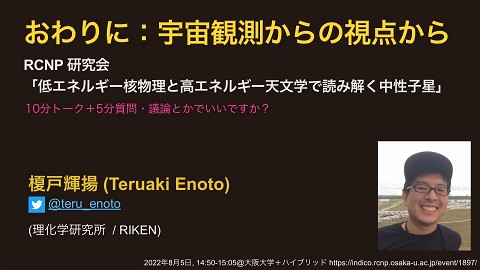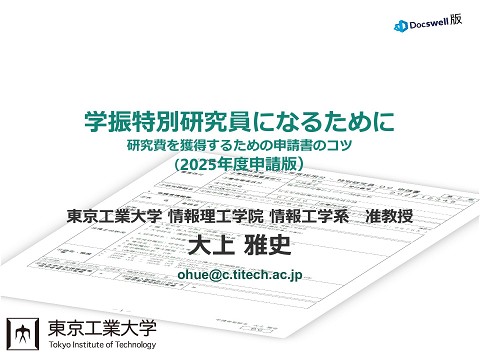Utilizing neutron exploration of lunar water resources for astronomy and particle physics
467 Views
September 30, 22
スライド概要
ISAS 惑星探査ワークショップ 2022
https://www.isas.jaxa.jp/researchers/symposium/pew/fy2022.html
2022年9月30日
http://enotolab.com
関連スライド
各ページのテキスト
Utilizing neutron exploration of lunar water resources for astronomy and particle physics @teru_enoto Teruaki Enoto / 榎戸輝揚 (RIKEN) On behalf of the MoMoTarO project September 30, 2022, 13:05-13:25 (20 min) @ ISAS Planetary Exploration Workshop 2022
Cosmic radiation measurement and application 2 (C) NASA/GSFC NICER (neutron star interior composition explorer)
Physics and astronomy around the Moon Lunar Gateway space station project (C) NASA Landing of a Falcon 9 rocket (C) SpaceX • Era of the vast tide of lunar exploration by governments and private companies. • Search for lunar water resources is the key to our space exploration. • Cosmic radiation measurements on the moon provide water resource exploration and innovative projects for astronomy and particle physics. 3
MoMoTarO (Moon Moisture Targeting Observatory) 4 Multidisciplinary project usinig neutron and gamma-ray detectors for 1. Lunar water search of planetary science 2. Gamma-ray burst observations in the multimessenger astronomy 3. Particle physics via neutron lifetime measurements
Collaborators and acknowledgements • Collaboration with multidisciplinary fields (planetary/earth science, civil engineering, astronomy, and • • particle/nuclear physics) • Teruaki Enoto, Hiroshi Nagaoka, Yo Kato, Naoki Tsuji, Kentaro Taniguchi, Yoshie Otake, Kunihiro Fujita, Yasuo Wakabayashi, Chihiro Iwamoto, Takaoki Takanashi, Toru Tamagawa (RIKEN), Makoto Hareyama (St. Marianna University School of Medicine), Taizo Kobayashi (Ritsumeikan University), Hiroki Kusano (QST), Taichi Ikenaga, Takao Nakano, Yuji Tsuakmoto (SRE), Takeshi Hoshino, Yuzuru Karoji, Munetaka Ueno (JAXA), Mareki Honma, Shintaro Yoshiura (NAOJ), Takeshi Morimoto (Kindai University), Hiromitsu Takahashi (Hiroshima University), Kazuhiro Nakazawa (Nagoya University), Kenta Hotokezaka (Tokyo Univ.) Supported by / Discussed with • Masanori Ohno (JAXA), Hiroya Yamaguchi (JAXA), Takanori Sakamoto (AGU), Hirokazu Odaka (Tokyo Univ.), Wataru Iwakiri (Chuo Univ.), Toshio Terasawa (NAOJ), Hiroaki Misawa (Tohoku Univ.), Shota Kisaka (Hiroshima Univ.) This project/activity is financially supported by • JAXA 宇宙探査イノベーションハブ・第6回 研究提案募集<A.課題解決型>小型・可搬型の地下水分センサ/地産地消型探査技 • • • 5 術「月面探査と土木建築でのデュアルユースを視野に入れた次世代型の中性子水モニタの開発」 JST 創発的研究支援事業「宇宙放射線の測定による月極域の水資源探査と月面天文学」 JAXA国際宇宙探査センター2021年度 月面での科学研究・技術実証ミッションにかかるフィジビリティスタディテーマ「課題 B:世界をリードする科学成果の月面活動からの創出」での「水資源探査とも連携した宇宙の暗黒時代に迫るガンマ線・低周波 電波の月面天文台」 理化学研究所・理研白眉研究プロジェクト「高エネルギー大気物理学の開拓と次世代の宇宙観測への応用」
1. Neutron exploration of lunar water resources 6
Cosmic rays produce signal of water resources Lunar rover Galactic cosmic rays (Proton, He) Thermal neutron 7 Water (proton) Fast neutron Nuclear reactions Gamma rays Neutron capture
Hydrogen concentrations in the lunar polar region? ometer (Lawrence et al. 2006) Hydrogen distribution at the lunar South Pole (below 70° latitude) S < - 70degree • Solar winds, meteorites, and comets supply • • • • Hydrogen Concentration (ppm) Hydrogen (ppm) Lawrence et al. 2006 Lunar Prospector Neutron Spectrometer 8 • water to the Moon. Water is expected to be concentrated in the permanent shadow of the lunar polar regions without the sun shine. The lunar orbiter's neutron spectrometer has observed water equivalent hydrogen (WEH) concentrations at the poles. Sub wt% water is expected in the WEH, at depths within tens of cm from the surface? Measurements from orbit are average water concentrations over a few dozens of km square. Possibility of local concentration. Would like to conduct detailed mapping of water resources with a neutron monitor on board the lunar rover Water Equivalent Hydrogen (WEH) is the amount of hydrogen [H] estimated by assuming that all the hydrogen measured by neutron measurements exists as water. Nine times this corresponds to the water content (i.e., [H2O] = [H] x 18/2). The figure shows WEH = enhancement = ([H]-[H]0) x 9, where [H]0 is the average non-polar level = 0.045% WEH
Geant4 simulation of neutron generation and propagation Galactic cosmic rays irradiating the lunar surface (input) Hayatsu et al. 2008 parameters "# ) Neutron spectrum leaking from the lunar surface (output) Thermal neutron 10-3-0.5 eV Epi-thermal neutron 0.5 eV - 0.5 MeV Fast neutron 0.5-10 MeV Low moisture cotent High moisture cotent H abundance • Leaking neutrons have the information of differences in moisture content, elemental composition of the lunar surface (Fe, Ti, Gd, Sm, etc.), porosity and temperature. Hydrogen content mainly affects epithermal neutrons, and compositional differences affect thermal and fast neutrons. 9 By H. Kusano, H. Nagaoka, S. Hareyama et al., (ref: Lawrence et al., 2013, Kusano et al. in preparation)
Scintillator neutron measurements with the PSD Fast (epithermal) neutron recoil proton α-particle • Thermal neutron electron Gamma ray 6Li scattering Tritium • Fast neutrons: lose energy mainly by elastic scatterings with • 10 • • Helium gas detectors have been protons (hydrogen nuclei). After thermalized, captured by 6Li. Thermal neutrons: Once captured by 6Li, the (n,α) reaction (Q value: ~4.8 MeV) releases an α-particles and 3H. Gamma rays: mainly Compton scattered. • used extensively in neutron measurements • Price escalation • vulnerable to vibration Utilization of new technology using lithium-doped plastic scintillators and multi-pixel photodetectors (SiPM) • Less expensive than helium • Highly resistant to vibration, compact and power-saving • Pulse shape discrimination (PSD) of neutrons and gamma rays Sensitive neutron measurements via background rejections • Measurement of abundance composition of the lunar soil
Example of neutron and gamma-ray discrimination hist Thermal neutron PSD value (arbitrary unit) 700 Scintillator Data Acquisition Distance between a neutron source and the sensor is 16 cm Fast neutron 300 650 250 600 200 550 150 500 450 400 100 Gamma rays Entries Mean x Mean y 91927 283 580.3 Std Dev x 181.8 Std Dev y 34.78 Integral 9.147e+04 PSD (Pulse Shape Discrimination) PSD value = Charge in the tail / Total charge 200 300 400 500 600 700 800 900 1000 100 50 0 Pulse height (ADC channel) [~deposited energy] • Laboratory model confirms discrimination of thermal, fast neutrons and gamma rays • We have started to design space environment models with scheduling thermal 11 environment test, radiation tolerance test, and vibration tests. By H. Nagaoka, N. Tsuji, K. Taniguchi, Y. Kato, H.Kato, et al.,
MoMoTarO (Moon Moisture Targeting Observatory) • • • • • Thermal and epi-thermal neutron detectors for non-contact search for lunar water Gamma-ray detectors to observe gamma-ray bursts and lunar soil abundance PSD scintillators and SiPM photo sensors with anti-coincidence background rejections One unit is 1U CubeSat size module, easily scalable to increase effective area Data acquisition board (DAQ) is developed based on the heritage of NinjaSat. MoMoTarO onboard the rover 10 cm Space 10 cm NinjaSat DAQ board Gamma-ray (GAGG 7x7x1 cm) Lunar surface 10 cm 9.5 cm Epithermal neutron (EJ-270 7x7x3 cm) 12 Thermal neutron (EJ-270 7x7x1 cm) BBM mockup 9.5 cm
CubeSat X-ray Observatory “NinjaSat” in 2023 RIKEN (Tamagawa lab & Enoto team) will launch the CubeSat X-ray Observatory “NinjaSat” in 2023. The payloads are gas Xray detectors with particle monitors. This experience and heritage could be used for the MoMoTarO project. Example target is an X-ray bright fast spinning neutron star Sco X-1, which is expected to emit persistent gravitational wave. 13 (C) NinjaSat team
Applications to industry and civil engineering • Neutron moisture monitors with a 252Cf neutron source have a wide range of applications • Civil engineering works (ground investigation, compaction) Soil compacted by heavy machinery • Non-destructive testing of concrete structures (bridges, dams and other structures, industrial complexes, etc.) • Contribution to future infrastructure maintenance in Japan • For example, there are 730,000 bridges in Japan. Inspection of fill condition with a RI instrument Inspection of construction sites (compaction) with RI instruments (C) Soil and rock engineering, SRE 14 Bridge inspections are conducted once every five years. Salt inspection is once every 10 years. • Our equipment and technical know-how developed for lunar exploration will be promoted for use in infrastructure inspections on the ground. By T. Kobayashi, T. Ikenaga, Y. Otake, Y. Wakabayashi, et al.
Differences in the moisture content and neutron flux 2/s) 2/s) Neutron flux (neutron/cm 中性子フラックス (neutron/cm 105 Concrete コンクリート (neutron beam (加速器による from an 中性子ビーム) accelerator) 104 103 102 RI measurements at civil 土木現場のRI計器活用 engineering sites 252Cf 中性子源) ((252 Cf neutron source) 10 1.0 月表面 Lunar surface (Neutron by Galactic cosmic rays) (銀河宇宙線による中性子) 0.1 10-2 JAXA TargetRFI の検出目標 of our project 0.1 Lightning 雷 1.0 10 質量含水率 (%)content (%) Mass moisture 100 太陽 Solar flare フレア • In contrast to the neutron measurement targets on the ground, extremely low 15 moisture content should be measured on the lunar surface!
3)⽉⾯模擬⼟壌を使⽤したRI線源による⽔分計測 3)⽉⾯模擬⼟壌を使⽤したRI線源に Low moisture measurement in Lunar simulant 1) ⽔を含む⼟槽作り 2) 線源と中性⼦検出器を設置 1) ⽔を含む⼟槽作り 2) 線源と中性⼦検出器を設置 3) ⼟槽からの中性⼦を測定 1. Prepare simulant with controlled moisture content 2. He3-gas neutron detector (SRE) on the lunar simulant box 3. Neutron measurement from a 252Cf Radiation isotope (RI) 4) 測定結果 計数率 (cps) • • • • • 16 0 Geant4_1(実験後) Geant4 結果1 多項式 (Geant4_1(実験後)) Geant4 結果1 近似曲線 50 Geant4_2(実験後) Geant4 結果2 多項式 (Geant4_2(実験後)) Geant4 結果2 近似曲線 実測値 実測値 • モデル⼟槽中の容積含⽔率と中 Measurements 性⼦計数率(He3計数管で測定) Geant4 simulation and との関係 Expected curves 実測値 実測値 45 計数率 Neutron rate(cps) (cps) • 4) 測定結果 FJS-1 実測vsGeant4 Test campaign on May 30-June 3,結果2 2022 at the Geant4_1(実験後) Geant4 結果1 Geant4_2(実験後) Geant4 多項式 (Geant4_1(実験後)) 多項式 (Geant4_2(実験後)) Geant4 結果1 Geant4 結果2 近似曲線 Kobayashi lab at近似曲線 Ritsumeikan University 50 Lunar simulant (FJS1) and sandy soil (真砂土) 45 Measurement of neutron count rates as a 40 function of volume moisture content 35 Good 30 agreement with our Geant4 simulated and25expected curves! We20established a control method to prepare low15moisture lunar regolith simulants, and verified the Geant4 simulation results. 10 We continue this campaign for new detectors. 5 FJS-1 実測vsGeant4 40 35 30 Two different assumptions of RI intensities • Geant4での数値シミュレー ションと実測した計数率を⽐較 25 20 15 • • • • • 実験結果との良い相関性を得た 10 FJS1 result 5 0 0.000% 0 • 今回の実験結果を踏まえ、さら 2.000% 4.000% 6.000% 8.000% 10.000% 12.000% 14.000% 2 4にモデル計算の⾼精度化を⽬指 6 8 10 12 14 Volume moisture content (%) す 容積含水率 (%) *G 強 で *Geant4の⼆種類の計算結果はCf線源の (H. Nagaoka,強度を公称値、出荷前計測値のそれぞれ T. Koyabasyi, T. Ikenaga, Y. Wakabayashi, et al.)
2. Gamma-ray burst monitors on the Moon, collaborating with low-frequency radio antennas Binary neutron star merger GW170817 Illustration of two merging neutron stars (C) NSF/LIGO/Sonoma State University/A. Simonnet
The Astrophysical Journal Letters, 848:L12 (59pp), 2017 October 20 A Multi-messenger Astronomy • GW170817 — Binary neutron star merger • Gravitational wave detected by aLIGO & aVirgo at 12:41:04 UTC, 2017 Agust 17 • 1.7 sec after the GW signal, a gammaray burst GRB 170817A detected • Within 11 hours, bright optical transient AT 2017gfo found in NGC 4993 (40 Mpc) • Merging two neutron star at a luminosity distance of 40±8 Mpc, followed by a short gamma-ray burst and a kilonova powered by radioactive decays of r-process nuclei. • Dawn of multi-messenger and time-domain astronomy!! 18 LIGO & Virgo Scientific Collaboration, ApJ (2017) Figure 2. Timeline of the discovery of GW170817, GRB 170817A, SSS17a/AT 2017gfo, and the follow-up observations are shown by messenger and
Localization is important! — GW, GRB, and EM ournal Letters, 848:L12 (59pp), 2017 October 20 (190 deg2) Abbott et al. • GW source localization in a sky region of 31 deg2 • Prompt short GRB detected by Fermi/GBM and INTEGRAL/SPI-ACS (31 deg2) • Fermi/GBM 90% probability (1100 deg2) region of 1100 deg2 • Arrival time difference between Fermi and INTEGRAL provides an annulus region constraint. • Optical tiling observations were needed • e.g., Subaru/HSC 1.5 deg FoV (diameter), of the gravitational-wave, gamma-ray, and optical signals. The left panel shows an orthographic projection of the 90% credible regions from 2 green), the initial LIGO-Virgo localization (31 deg green), IPN triangulation from the ApJ time delay between Fermi and INTEGRAL (light LIGO &; dark Virgo Scientific Collaboration, (2017) 19 (dark blue). The inset shows the location of the apparent host galaxy NGC 4993 in the Swope optical discovery image at 10.9 hr after the Moon ~0.5 deg
f Hurley et al. (2000b); Hurley et al. (2000c); Laros et al. (1998); Hurley et al. (1999a); Hurley et al. (2005); The Astrophysical Journal Supplement Series, 259:34 (10pp), 2022 April g h i j Laros et al. (1997); Hurley et al. (1999b); Pal’shin et al. (2013); Hurley et al. (2011b); Hurley et al. (2010); Hurley et al. (2011a); l Present catalog. Triangulation — Arrival time analysis of GRBs k terminated and new missions are introduced. During the period covered in the present catalog, the IPN consisted of Konus-Wind, at distances up to around 5 lt-s from Earth (Aptekar et al. 1995); Mars Odyssey, in orbit around Mars at up to 1250 lt-s GRB from Earth (Hurley et al. 2006); the International Gamma-Ray Hurley et al., ApJS (2013) Laboratory (INTEGRAL), in an eccentric Earth orbit at up to cos θ12=c∆t12/d12 0.5 lt-s from Earth (Rau et al. 2005); the Mercury Surface, 2-3 annulus Space Environment, Geochemistry, and Ranging mission (MESSENGER), launched in 2004 August, and in an eccentric θ12 orbit around Mercury beginning 2011 March 18, up to 690 lt-s d12 from Earth (Gold et al. 2001); and the Ramaty High Energy 1 2 The Astrophysical Journal Supplement Series, 259:34 (10pp), 2022 April Solar Spectroscopic Imager (RHESSI; Smith et al. 2002), Swift GRB 170206A Svinkin et al (Goldstein et al. 2012), Fermi (Meegan et al. Sivinkin 2009), Suzaku et al., ApJS (2022) 1-2 annulus (Takahashi et al. 2007; Yamaoka et al. 2009), and AGILE 3 (Marisaldi et al. 2008; Del Monte et al. 2008; Tavani et al. 2009), all in low Earth orbit. Figure 1. The triangulation technique. Each independent spacecraft pair is used to derive an annulus of location for the burst. ⊿T Three between spacecraft producetwo spacecrafts The detectors in at the IPN vary widely in shape, composition, Arrival time difference two possible error boxes. The ambiguity can be eliminated by the addition of time resolution, and energy range. Also, onboard timekeeping a fourth,distance non-coplanar spacecraft by the anisotropic response ofwith one of its the half-angle θ. D makes an annual techniques and accuracies are not the same from mission to misexperiments, or by the GBM localization. sion, and spacecraft ephemeris data are given only as predicts for some missions. Since the accuracy of the triangulation tech2. TECHNIQUE, INSTRUMENTATION, CALIBRATION, nique depends on all these parameters, end-to-end calibrations AND SENSITIVITY and sensitivity checks are a constant necessity. For the current IPN, we currently utilize the following Planetary 1994, 9 method. For every burst for which The Inter triangulation technique Network is illustrated in(IPN): Figure 1.started When the Swift X-Ray Telescope (XRT) detects an X-ray afterglow, we a GRBspacecrafts, arrives at two spacecraft with a delay δT , it may be the total short GRBs of 495search events detected for GRB detections in all the IPN experiments. If the burst localized to an annulus whose half-angle θ with respect to the was detected by (1) Odyssey and Konus or by Odyssey and a nearwith the Konus-Wind in orbit at the Lagrangian point L1 vector joining the two spacecraft is given by 20 Earth mission, (2) MESSENGER and Konus or by MESSENGER • •
GRB localization by distant spacecrafts (s/c) The Astrophysical Journal Supplement Series, 259:34 (10pp), 2022 April • Annulus sky region width (error range) Svinkin et al. 0.12 deg2 Uncertainty of the time delay • Reducing the geometric mean of the error 11 deg2 region using a distance s/c. (Low-Earth orbit) • 11 2 0.12 deg (Distant spacecrafts) • deg2 • Only a few and old distant spacecrafts… aLIGO/aVirgo GW170817 Subaru HSC Fermi/GBM only GW170817 • Konus-Wind (L1) • Full sky coverage by two detectors • Energy band: 20-15 MeV • Sensitivity GRB fluence >10-6 erg s-1 cm-2 21 • Mars Odyssey (around Mars, unto ~1250 lt-s) (around Mercury, unto ~700 lt-s) • Messenger Figure 4. Distributions of minimum sizes (left) and areas (right) of the IPN localizations. Blue dotted lines: 94 Konus short bursts observedetbyal., at least one distant s/c; Sivinkin ApJS (2022) red dashed lines: 105 bursts not observed by any distant s/c. The minimum region dimensions range from 0°. 033 (2 0) to 3°. 32 with a mean of 0°. 17, and a geometric
Application to Gravitational Wave (GW) Cosmology GW170817 • GRB Identification of host galaxies is essential to connect the GW and EM. short • Key step is localization of prompt 0 1 GRBs (<0.1-1 deg2) with 10 a wide10 FoV. 10 GW GW standard siren I r e dd a t s i D LVK ~2030 ~2040 e s r e nv a l e nc • Independent from the canonical “cosmic ladder”, and free from potential systematic uncertainties. GRB Kilonova provides a new probe for the cosmic expansion history. • GW signal (strain) → Absolute distance scale (Luminosity distance) • EM counterparts (galaxy, kilonova) → Redshift z=2 d a l r e d BAO Lens CMB • Multi-messenger GW-EM astronomy z=0.2 SN Ia Tully-Fisher Maser Cepheid variables Red giant branch Eclipsing binary Parallax 2 10 3 4 5 6 (C) K. Hotokezaka 7 10 10 10 10 10 Distance from the SunDistance (pc) Co-moving (pc) 8 10 9 10 10 22
Cosmology Puzzles • The Hubble tension — Systematic difference of • Although we report results for only one year of observations, a longer observing period is of course likely. For example, we find that with 5 years of observation, uncertainties on the cosmological parameters improve by a factor of about 1.5–2. 68% uncertainty of the cosmological parameter w0 • the Hubble constant H0 between the CMB measurements and SNIa methods Dark energy puzzle — the GW cosmology can measure Cosmological parameters (H0, Ωm, w). GRB localization on the Moon is on this story. 23 2. CE Swift and Swift+: Similarly, only a few SGRB events are sufficient to achieve comparable precision on (Ωm, w0) measurement as the CE VRO 600s or VRO 1800s scenarios. In addition to the benefit of the inclination angle constraint, the SGRB sample reaches higher redshifts than kilonovae in the CE era. 3. CE Swift++: Given the greater number of SGRBs and their larger detection distance, (Ωm, w0) can be measured to 20%–30% precision over one year of observations. Unlike in the kilonova case, even in the Swift++ scenario, we are not limited by the gamma-ray telescope time (though constraints on spectroscopic follow-up may be more severe; see below). 4.1. Uncertainties and Caveats Chen et al., ApJL (2021) Voyager Motivated empirically by observations with Swift, we have assumed that 30% of SGRBs detected by the gamma-ray satellite will have their redshift precisely determined. While it is potentially realistic to obtain spectroscopic follow-up of SGRB afterglows or host galaxies in the era of a few (or even a few dozen) events per year, our CE Swift++ scenario would require about 100 redshift measurements per year, possibly from 8etmal., class or (2021) larger spectroscopic telescopes (given the Valentino CQG large distances of SGRBs) by the 2040s when CE is
Contributions from Lunar GRB detectors
and fluence sensitivity >5×10-8 erg s-1 cm-2 (Background is mild than LEO)
XDF (see Right panel)
1 deg
(C) T. Rector, I. Dell'Antonio/NOAO/AURA/NSF, Digitized Sky Survey
(DSS), STScI/AURA, Palomar/Caltech, and UKSTU/AAO
2.0’ = 0.033 deg
• 2-3 MoMoTarO-like detectors at lunar rover, the gateway, and CubeSats
• Prompt short GRB localization to connect between GW and EM (Optical/Infrared)
• Requirement: full sky coverage (vs. Swift/BAT ~0.1 of sky), localization of 0.1 deg2
2.3’ = 0.038 deg
Hubble eXtreme Deep Field taken
5,500 galaxies in the image (2012)
(C) NASA; ESA; G. Illingworth, D. Magee, and P. Oesch, University of
California, Santa Cruz; R. Bouwens, Leiden University; and the HUDF09 Team
24
(f) are photo index γ, Ecut and Epeak of the CPL model. The errors are given at the ence level.(see Methods for details the saturation and the deadtime correction.) Collaboration withof low-frequency radio observations • Simultaneous radio and gamma-ray observations of astronomical and cosmological Rate (104 counts/s) • bursts are a promising new field of time domain astronomy. Moon provides ideal low-noise radio observation sites collaborated with gamma rays. 8 6 Soft gamma rays (27-250 keV) HXMT-HE (a) 4 2 0 -500 -400 -300 -200 -100 0 100 a (b) b (c) Frequency (MHz) 800 (Credit) NASA/JPL-Caltech 200 300 (d) CHIME 700 600 400 Example science: Mysteries of a connection between cosmological fast radio bursts and highly magnetized neutron stars (magnetars) Soft gamma-ray burst detected from the Galactic Time (ms) magnetar SGR 1935+2154, which was simultaneously detected as Fast Radio Bursts Table 1 | Properties of the burst from SGR 1935+2154 (FRBs). The soft gamma-ray burst from the Chinese X-ray telescope HMXT (a, Li et al., Nature Parameter Component 1 Component 2 Astronomy, 2021) was also detected simultaneously −3 ) 332.7206(9) Dispersion measure (pc cm by two radio telescopes, the STARE2 telescope in the U.S. (b,a Bochenek et al., Nature, 2020) and the 0.759(8) Scattering timescale (ms) CHIME telescope in Canada (c, CHIME/FRB 264 Best-fit S/Nb collaboration, Nature, 2020). It is believed that this 14:34:24.43755( Arrival time, 28 April originates 2020 (UTC, from a 14:34:24.40858(2) event magnetic reconnection on the c topocentric) surface of a magnetar (d). Arrival time, 28 April 2020 (UTC, geocentric)c,d 500 400 –15 0 15 30 45 (ms) –15 Time 0 15 14:34:24.42650(2) 14:34:24.45547( By T. Morimoto, M. Honma, Scattering-corrected width (ms) 0.585(14) S. Yoshiura, H. Takahashi, 0.335(7) (Credit) NASA/GSFC, Chris Smith (USRA) a,b −5.75(11) 3.61(8) 25 Spectral index K. Nakazawa, et al. 30 45 b
3. Neutron life-time puzzle — the lunar neutron measurements
Unsolved “neutron lifetime puzzle” • Systematic difference of the neutron lifetime between the beam method (τbeam~888 sec) and the bottle method (τbottle~879 sec), △τ = τbeam - τbottle = 9 sec (1%) • Important parameter for the big-bang nucleosynthes. Signature of the dark matter? 月 thermal neutron Planet Galactic cosmic rays 従来の方法 Previous studies neutron beam proton cold neutron t 27 t Beam Bottle Neutron lifetime (sec) Proposing method Beam ビーム法 Bottle ボトル法 プラネット法 Planet (先行研究) QCD 計算 QCD Beam method Bottle method Year
Cosmic rays produce signal of water resources Lunar rover Galactic cosmic rays (Proton, He) Thermal neutron 28 Water (proton) Fast neutron Nuclear reactions Gamma rays 中性子捕獲
Lifetime measurement using a lunar orbiter Wilson et al., Physical Review C (2021) • Thermal neutrons leaked from the lunar surface can be used for the neutron lifetime measurement. • Re-analysis of the neutron spectrometer (gas detector) onboard the Lunar Prospector (LP) reported the neutron lifetime τplanet of 887±14(stat.)+7/-3(syst). • Only use the data for 9 elliptical orbits before transitioning to a circular orbit (about 2 days). Altitude below 7500 km Effective area of neutron about 70 cm2 • 29 • • Unfortunately, the short measurement exposure and small statistics hampered distinguish between the two lifetimes.
CubeSat Lunar orbiter can measure the lifetime! F (neutron s-1 cm-2) 0.3 0.2 • We built a simulation framework of thermal neutron thermal neutron flux simulation (1 meV-0.5 eV) 0.1 leakage and transport in space. • Geant4 simulation of galactic cosmic-ray interaction with the lunar surface material for neutron leakage (energy, direction, and flux). • Neutron transportation in space based on Feldman et al., JGR (1989) adding the beta decay at different neutron lifetime. δF (10-4 n s-1 cm-2) 0.0 30 • 4 • CubeSat lunar orbiter with 2U-size MoMoTarO-like 3 detector can distinguish the two lifetime within a half year measurement compared with the model. 2 1 0 Thermal neutron flux ~0.1 cps/cm2 at 600 km Flux difference δF = Fsim(τBeam)-Fmodel(τBottle) 1000 2000 Altitude (km) • Assumed orbit: altitude 20-2000 km • 1U-MoMoTarO: 7x7 cm2 area with efficiency 80% By K. Taniguchi, H. Kusano, T. Takanashi, N. Tsuji, S. Hareyama et al.
Reducing systematic and increasing feasibility Neuron imager (e.g.,) ISS SpySE 98 mm Coded mask B 4C Array-type scintillators SiPM array 95 mm GS-20 3.2 mm pixel 24 x 24 Electronic LAWRENCE ET AL.: IRON ABUNDANCES ON THE LUNAR SURFACE 13 - 15 CubeSat size Space verification Active shield scent. Latitude (°) 31 leakage and transportation taking into account spatial difference of the lunar surface abundance. • development of the thermal +90 neutron imager (the codedmask and anti-coincidence technique) to reduce potential systematic uncertainties. +45 0 • space verification within a few -45 -90 • We are working … • improvement of the neutron Relative neutron flux on the moon -180 -90 0 Longitude (°) +90 Figure 16. Map of the temperature corrected, normalized neutron number density. +180 years by CubeSats or ISS exposed services for TRL9. By N. Tsuji, H. Nagaoka, T. Kentaro et al.,
MoMoTarO (Moon Moisture Targeting Observatory) 32 Multidisciplinary project usinig neutron and gamma-ray detectors for 1. Lunar water search of planetary science 2. Gamma-ray burst observations in the multimessenger astronomy 3. Particle physics via neutron lifetime measurements
Summary Collaboration and comments are welcome! teruaki.enoto <at> riken.jp • Moon Moisture Targeting Observatory (MoMoTarO) is a neutron and gammaray radiation monitor to be onboard lunar rovers, the Gateway, and CubeSat around the moon, using new techniques of scintillators and SiPM sensors. • MoMoTarO measures both thermal and epithermal neutrons to search for water on the lunar surface. We established a mock examination method of low water-content lunar simulant, and working to make an engineering model. • As astronomical applications, precise GRB localizations using wide field-ofview gamma-ray detectors on the moon provide an essential step for the gravitational wave cosmology to solve the Hubble tension and dark energy. • Simultaneous low-frequency radio monitoring is important for time-domain astronomy, such as mysteries of magnetars and fast radio bursts. • Thermal neutron measurement around the Moon at ~500 km altitude provides the 3rd independent and meaningful method for the neutron life-time puzzle. 33

